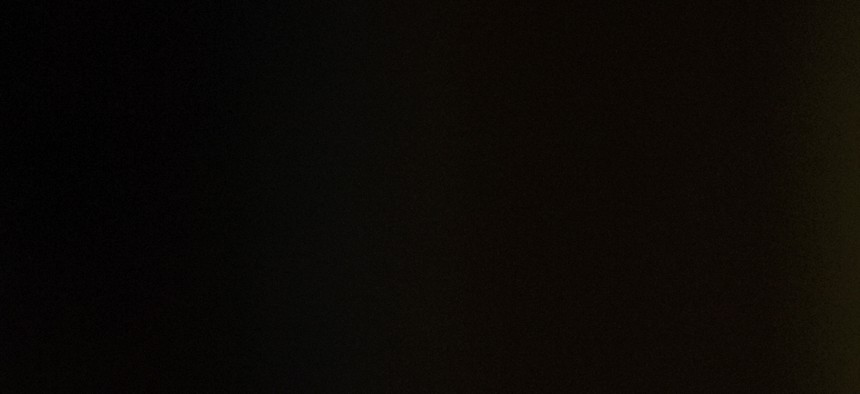
Director of National Intelligence James Clapper testifies on Capitol Hill in Washington, Thursday, Feb. 26, 2015, before the Senate Armed Services Committee to deliver the annual assessment by intelligence agencies. AP / J. SCOTT APPLEWHITE
Clapper Says People in Mosul May Be Getting Sick of ISIS
The nation’s top spy offered a bleak assessment of the nation’s threats.
Terrorism has reached a crisis point unseen in the 45 years that the Pentagon has been compiling such data, the nation’s top spy said on Thursday, giving Congress a grim analysis of the threats facing the nation. The clear leader among terrorist groups concerning the intelligence community, he indicated, remains the Islamic State, or ISIS.
While the intelligence community does not have “census bureau” accuracy of the size of ISIS, Director of National Intelligence James Clapper said that they estimate the group fluctuates between 20,000 to 32,000 fighters, echoing reports from September. Though he added that it was difficult to assess who was a “full-time” fighter and who was a supporting cast member. “From my vantage, it's unfortunate these numbers get out,” Clapper said.
Lt. Gen. Vincent Stewart, the new commander of the Defense Intelligence Agency, who accompanied Clapper to testify before the Senate Armed Services Committee, indicated that it would take Iraq an additional six to nine months to train three new brigades Iraq was bringing online to fight the Islamic State.
The size of ISIS and the U.S.-led coalition forces being amassed to fight the terrorist group has drawn new attention since last week when an official with U.S. Central Command said that up to 25,000 Iraqi and Kurdish troops were being trained to take back the city of Mosul from between 1,000 to 2,000 ISIS fighters.
Sen. Angus King, I-Maine, asked Stewart what size force would be sufficient to fight an urban war against ISIS. Stewart answered that the general rule for urban warfare was an invading force of 10 to 1.
But it’s not just the Islamic State that’s hard to pin down – Clapper also said the Russian cyber threat was “more severe” than the Intelligence Community had assessed prior. China is aggressively expanding into the South China Sea. Libya has become a terrorism magnet, currently harboring anywhere from six to eight terrorist groups, in addition to ISIS, “because it’s ungoverned.” And Turkey did not take seriously the issue of foreign fighters crossing through their border into Syria and Iraq, an problem since 60 percent of the fighters entering Syria to join the terrorist group go through Turkey, according to Clapper.
“Are you optimistic that Turkey will be more engaged than they have been?” asked Sen. Jeanne Shaheen, D-N.H.
“No, I'm not,” said Clapper. “I think Turkey has other priorities and other interests.” Turkey is more concerned with Kurdish power growing, which he argued created the “permissive environment” for foreign fighters to flow into Syria.
If there was one bright spot in the Clapper’s testimony, it is this: life under ISIS is miserable.
The director reported, “anecdotal evidence of resentment and resistance” against ISIS in places like Mosul because of the way the group enforces Sharia law. “They’re having challenges with governance,” the director said. “They don’t have the financial wherewithal to run a city.” He pointed to “signs of electricity outages, shortages of food and commodities.”
Airstrikes, he said, were proving effective against the group’s ability to refine crude to sell on the black market. “They’re going to mom-and-pop refining stills,” he said.
The Islamic State also has a growing problem with desertion. “They lost 3,000 fighters in Kobani,” said Clapper, adding that the loss was due to attrition, not air strikes. He also indicated that in some areas, the Islamic State has resorted to conscription.
The debate over arming Ukraine’s rebels also continued in the hearing, where DIA’s new chief indicated he, too, felt it was a futile proposition because Ukrainian fighters would never be able to resupply those arms faster than Russia.
“Russia and the separatists have significant interior lines that they can resupply a lot faster with a lot heavier weapons than we could deliver,” he said. “So it would be a race to see who could arm – and I think with their interior lines, they would have a significant advantage on the ground.”
That didn’t pacify SASC Chairman Sen. John McCain, R-Ariz., who said that the Russians had better supply in Afghanistan. Ultimately, Russian forces were driven out in part thanks to Western aid to Afghan resistance.
